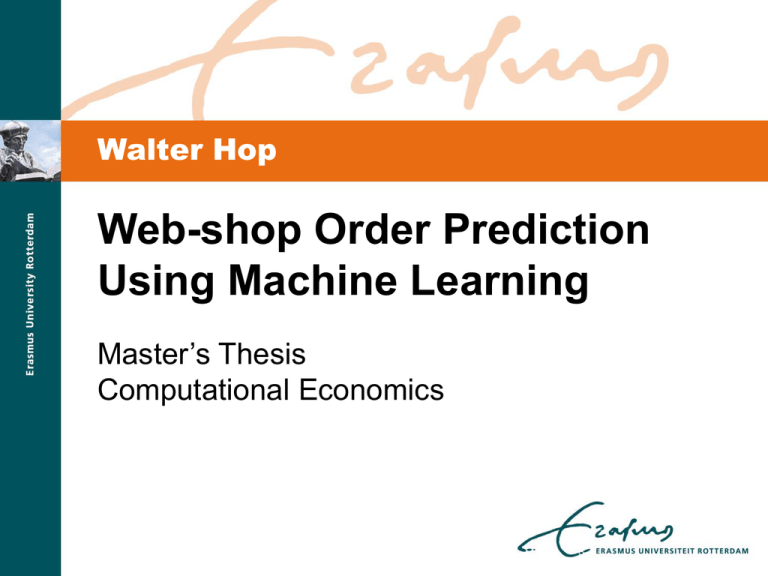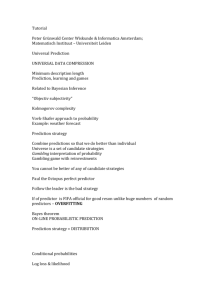Presentation 1.8MB pptx
advertisement

Walter Hop Web-shop Order Prediction Using Machine Learning Master’s Thesis Computational Economics Background E-commerce is displacing physical stores Maximize customer interest/turnover • Physical store • Human contact with customers • Expert advice • Web shop • Customize web shop experience • Big spender: Upselling, package deals • Small spender: Discounts • But who is who? De Volkskrant, 27 aug 2013 Data mining Text Webserver log files Customer database (CRM) 400,000 transactions by customers Data mining 24 attributes known of a customer transaction: • day and time • maximum price of products viewed • price of products put in shopping basket • stock levels of products • customer age, gender, # past orders • step in order process etc… Many transactions have some missing data Research problem Order prediction: Will the customer place an order during this website visit? • Which algorithm can best predict order probability, based on transaction data? • How to deal with missing data? • Can we improve predictions by combining prediction algorithms? Train/test data: DMC 2013 Feature extraction Derive variables for a user session (visit) from all component transactions Use aggregation operators • average: e.g. average price of products • count: e.g. number of transactions • sum: e.g. total time spent browsing the site • standard deviation: e.g. similarity of prices • etc… 62 features Handling missing data (56%) • Exclude incomplete sessions from analysis • Imputation: replace missing value by a new generated value • Mean imputation • Predictive imputation • Unique-value imputation: use an extreme value, such as –1 Imputation: No difference in prediction Prefer simple imputation: unique-value Prediction algorithms Random Forest • 500 decision trees • Trees are diverse • Bootstrapping • Only look at some variables + Very fast + Few parameters to set + Internal error estimate Prediction algorithms Support Vector Machine • Numerical optimization • Finds best separating hyperplane in high-dimensional space + Recognizes complex patterns + Guarantees wide margin – Slow tuning by cross-validation Prediction algorithms Neural network • Neurons, connections • Weights adapted by training examples + Similar to human brain – Many parameters – Unstable results – Not guaranteed to converge Combining algorithms Stacked generalization • Meta-classifier: learns from the output of various models • Determines for each class the best linear combination of models • Can use ordinary linear regression, SVM regression – Requires custom code in R – Extremely slow training Prediction accuracy Model Random Forest Support Vector Machine Neural network Stack: ordinary least-squares Stack: SVM regression Accuracy 90.3% 86.8% 75.6% 90.3% 90.3% Random Forest makes most accurate predictions Stacking does not help in our situation DMC 2013 Competition • 63 teams created predictions • Best accuracy = 97.2% • 160 features • Average of 600 decision trees from bootstrap sample (bagging) • C4.5 decision tree algorithm Difference likely due to feature extraction Limitations • Webserver log data is collected during visit • But at end of visit, it may be too late to influence customer • When using only customer data, accuracy drops from 90.3% to 69.2% • Accuracies may vary on other data sets Principal Findings Order prediction possible to large degree • Random Forest highly recommended • Good accuracy • Fast model • For prediction problems, simple imputation methods are sufficient • Iterate quickly, adding new features • Stacking not useful in this regard • Inflexible, no accuracy gain Thank you for your attention! lifeforms.nl/thesis Questions and Comments lifeforms.nl/thesis











